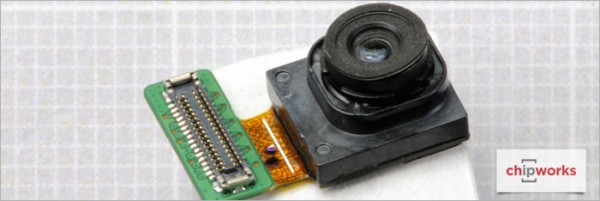
Lots of companies use Sony image sensors. Apple has since iPhone 4S. Nikon and Pentax use them. Now you can add Samsung to the mix as well.
Our lab staff have removed the imaging chip from the 12 MP camera module and have found a Sony back-illuminated (Exmor R) CMOS image sensor
This is a big win for Sony as I’m sure Samsung will do good, if not decent numbers with the Galaxy S7.
Sony hasn’t publicly announced the IMX260, but based on what we’ve been reading, we assume that is the part number. It’s a bit of a surprise that the IMX260 isn’t an Exmor RS sensor, as we’ve been documenting a lot of Sony design wins based on its 1st and 2nd generation Exmor RS technology. It seems the full chip PDAF functionality, which requires dual readout from each pixel, was implemented with a multi-chip solution rather than a stacked (CIS + ISP) solution.
The Sony IMX260 die size, as measured from the die seals, is 6.69 mm x 5.55 mm (37.1 mm2). There are no conventional die identification markings in use on the die, consistent with back-illuminated (stacked/non-stacked) Sony CIS chips. We confirmed a pixel pitch of 1.4 µm and a Bayer-patterned color filter array.
Some more deep-diving tech details after the jump.
Our lab staff have completed the initial cross-sectioning work for our IMX260 project and we have a substantial update to share: the Sony IMX260 is, in fact, a stacked chip CMOS image sensor! As mentioned, we had expected to find through silicon vias (TSVs) consistent with Sony’s Exmor RS technology platform. Our early teardown results revealed what appeared to be a conventional Sony non-stacked back-illuminated (Exmor R) chip. After going deeper inside, we see that Sony is leading the digital imaging sector into an era of hybrid bonding. It’s not currently known if Sony considers this an extension of its Exmor RS platform, or if the IMX260 marks the first of a new (as of now unannounced) family of back-illuminated image sensors. For now we consider the IMX260 to be a 3rd generation Exmor RS chip.
To a great many of you (including yours truly), half of that is pure tech jargon but what it translates to is better profits in 2016 for Sony’s image sensor division which has become one of the key pillars for the company. If Sony is also able to secure the inevitable iPhone 7 which will once again take a leap forward with its camera technology, it could be a very sweet 2016 for their bottom line.
My thanks to reader Junior Rider for pointing me towards this.
Discuss:
Are you surprised to find a Sony image sensor in the Galaxy S7?
[Via chipworks]
